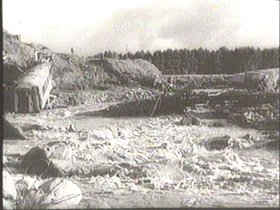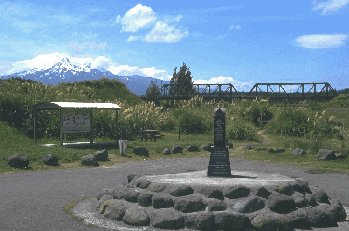![]()
Coasts
Rivers/Lakes
Lowlands/Plains
Geysers/Mud
Glaciers
Mt. Ruapehu
Mt. Cook
White Island
A Maori Legend
![]()
Abbotsford
Aramoana
Ballantynes
Brynderwyns
Cave Creek
Hawkes Bay
H.M.S. Orpheus
Influenza
Mt. Erebus
Mt. Tarawera
Rainbow Warrior
Seacliff Hospital
Tangiwai
Wahine
![]()
Annie Aves
Ata-hoe
Daisy Basham
Jean Batten
Minnie Dean
Mabel Howard
Margaret Mahy
Kath Mansfield
Kate Sheppard
Kiri Te Kanawa
Catherine Tizard
Murray Ball
Charles Goldie
Edmund Hillary
Richard Pearse
Lord Rutherford
Charles Upham
![]()
NZ FAQ--Funny
NZ Links
Credits
December 24th, 1953. As the end of 1953 dawned on the horizon it seemed New Zealand had a lot to celebrate. It was the first visit to New Zealand of Queen Elizabeth II, it was the year of her coronation. Sir Edmund Hillary and Sherpa Tenzing had become the first men to conquer Mt. Everest, and it was nearly Christmas Day. But the country was about to be shaken by the fifth worst disaster in our history and -- at the time -- the eighth biggest rail disaster in the world. New Zealand's greatest disaster was the crash of a DC10 on Mt. Erebus (toll 257), next was the Hawkes Bay earthquake (toll 256), the wreck of the H.M.S. Orpheus took 185 lives and the eruption of Mt. Tarawera cost another 153. Tangiwai would exact a death toll of 151, taking men, women and children in a most horrific manner. As the Wellington to Auckland express barrelled down the track towards the Whangaehu River at Tangiwai a roaring torrent of lahar water from the crater lake of Mt. Ruapehu carried away the massive concrete piers of the rail bridge, wrecked the adjacent road bridge and swept on down to damage three smaller bridges nearer the coast. Only minutes later, in total darkness, the locomotive Ka949 swept towards the bridge. Cyril Ellis was passing by and had seen the torrent of water. He did not know the bridge was out but everything told him the train could never cross safely under these conditions. Picking up a torch he ran in the direction of the train, waving, desperately trying to warn the driver. He jumped clear as the locomotive roared past and yelled to the driver, hoping against all hope that he would be heard. There was no chance above the noise of both engine and river. The engine
drawing the express was a 1400 hp monster built in 1939. It was
running well after a complete overhaul only four months prior to
the accident. Responsible for the smooth operation of the engine
and the safety of the passengers were Charles Parker, driver of
the express and a man with 33 years experience, and his fireman
Lance Redman. There had been no rain, neither man had reason to
expect trouble. Both died when, at 10.20 p.m., the express raced
onto the sagging bridge. With the concrete piers washed out there
was no support for the train. The rails buckled and plunged
into the raging torrent below. The engine nose-dived off the southern
bank, flew through the air and nearly reached the other bank before
crashing to the ground.
The first carriage went with it while the second carriage reared into the air and took the next three into the water as well. The first of the first-class coaches balanced precariously for some minutes on the edge of the rails before the coupling snapped and it followed the rest into the water. That left three carriages and two vans still on the track. Two of the carriages managed to survive the fall and subsequent somersaulting they took. These gave up most of the survivors. Passengers were plastered with mud and soaked with oil from the destroyed engine. Some were temporarily blinded from the oil in their eyes. They clambered onto the roofs of carriages or held whatever was handy waiting for rescue. These were the lucky ones. Others had no chance and were drowned or suffocated by the thick silt in the river. Some were swept down river 120 kms and out to the ocean. Their bodies were never recovered. The river rather than the impact took most of the lives. Almost all of the bodies recovered had no outward sign of injury however the current had stripped many people of their clothes and shoes. Those who escaped were also unmarked though extremely shocked and confused. At the time of the accident the river was running at six metres above normal. When the express ploughed into the water the river was at its peak. Only an hour later it had already dropped by several metres and two hours later it was only a metre or so above normal. On Christmas Day New Zealand awoke to the news of the tragedy. Images and reports sped around the world. Photographs showed the area resembling a vast mudflat, littered with debris, wrecked cars, boulders, trees and the remains of the engine. Of the 60 metre railway span only a tiny bit still stood on the southern end. The Waiouru military camp set up a makeshift morgue in a brightly decorated hall prepared for the children's Christmas party. Half open coffins were lined up in orderly rows. On Sunday 27th a special train pulled out of Waiouru. On the side were chalked white crosses, the dead were returning home for burial. Clean up time at the wreck site was extensive and involved slicing the engine into some pieces, it was too heavy to be moved any other way. A Commission of Inquiry found that no one was to blame however they did note that previous lahars had occurred in this spot. An early warning system is now in place at Tangiwai along with a back up. The commission also found evidence that the brakes on the engine had been applied 300 metres from the bridge, an indication that engine driver Charles Parker did spot the waving torch of Cyril Ellis. While the warning came too late to save the lives of 151 people on the express it no doubt saved the lives of those in the remaining three carriages. Without the braking all the remaining carriages would most certainly have careened into the water as well. The Queen's message on Christmas Day included a special note to those who had lost loved ones in this disaster. Late the Queen and Duke of Edinburgh met some of the survivors and the Duke changed his schedule so so as to attend a state funeral held in Wellington. Cyril Ellis received the George Medal for his actions that night in saving many lives and rescuing survivors. Tangiwai means 'Weeping Waters'. Each Christmas Eve as the express approaches the Whangaehu River it slows to walking pace and the duty driver casts into the water a bunch of flowers. The card attached reads, "In memory of all who died at Tangiwai on Christmas Eve, 1953."
|






